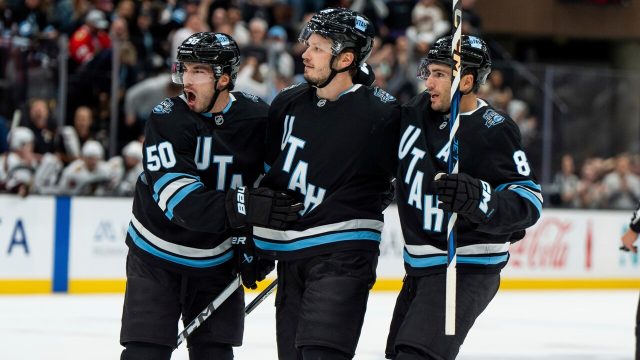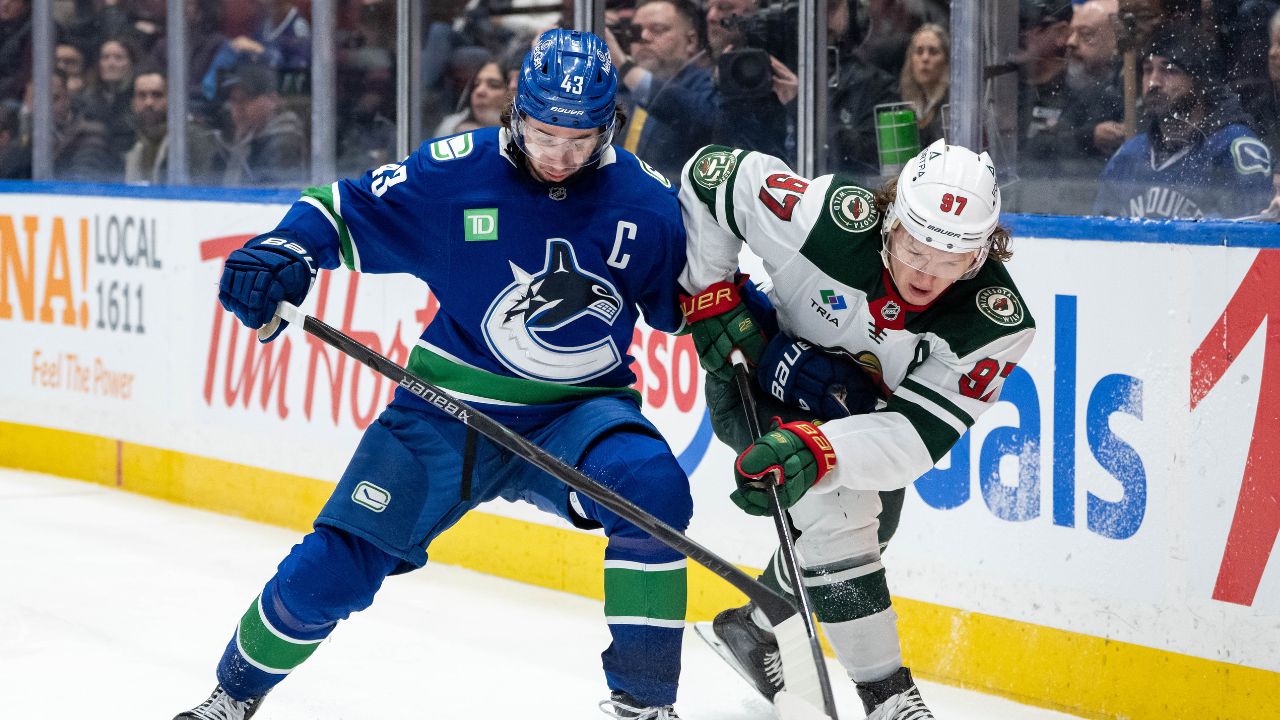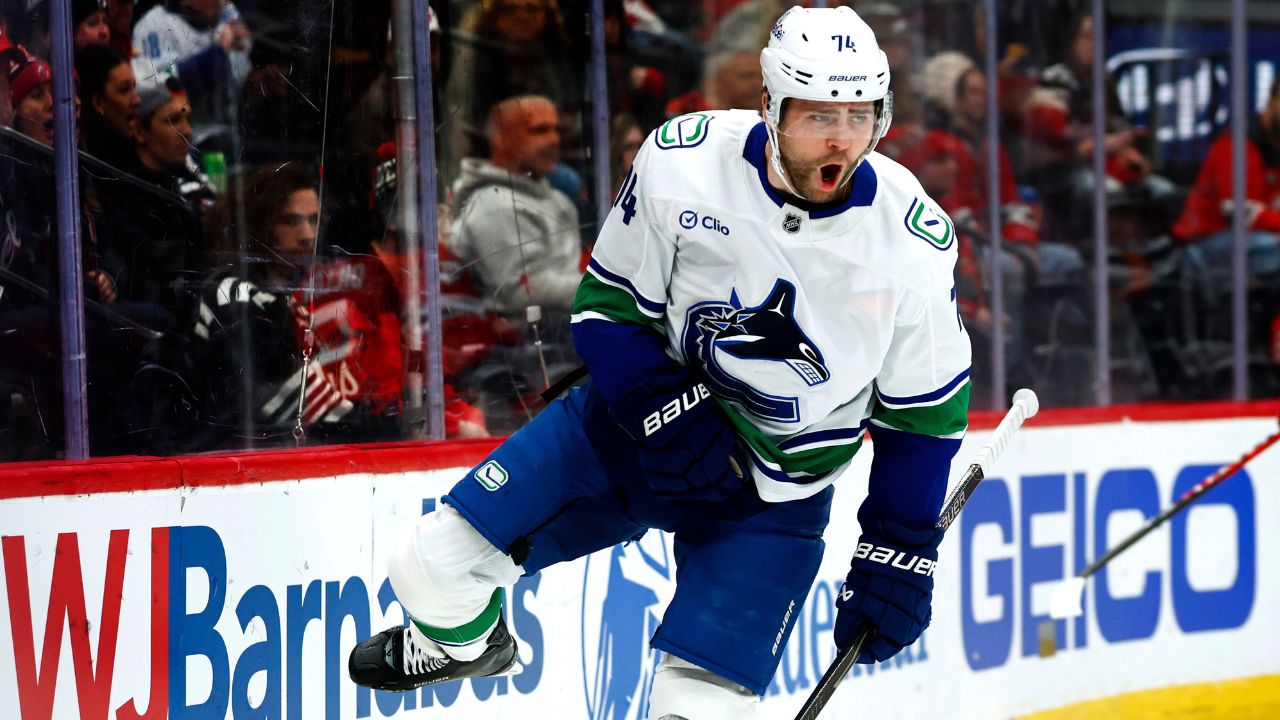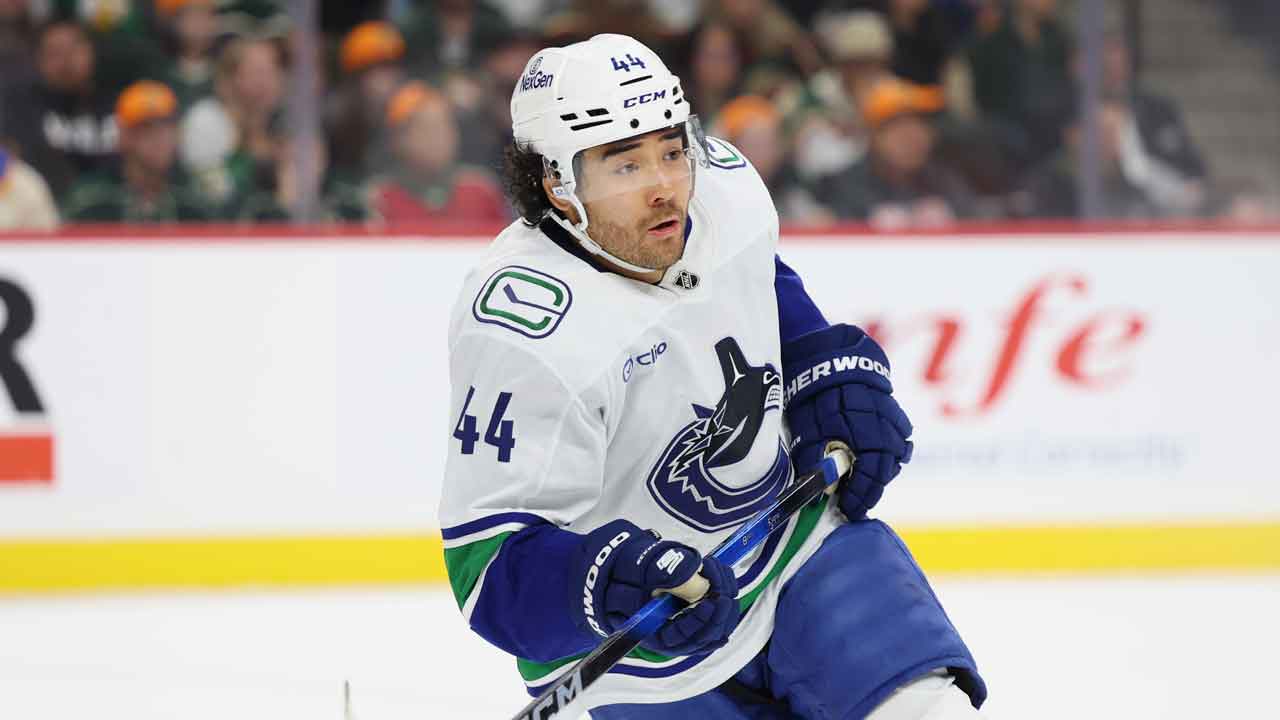
NOT WEIRD, BUT DIFFERENT
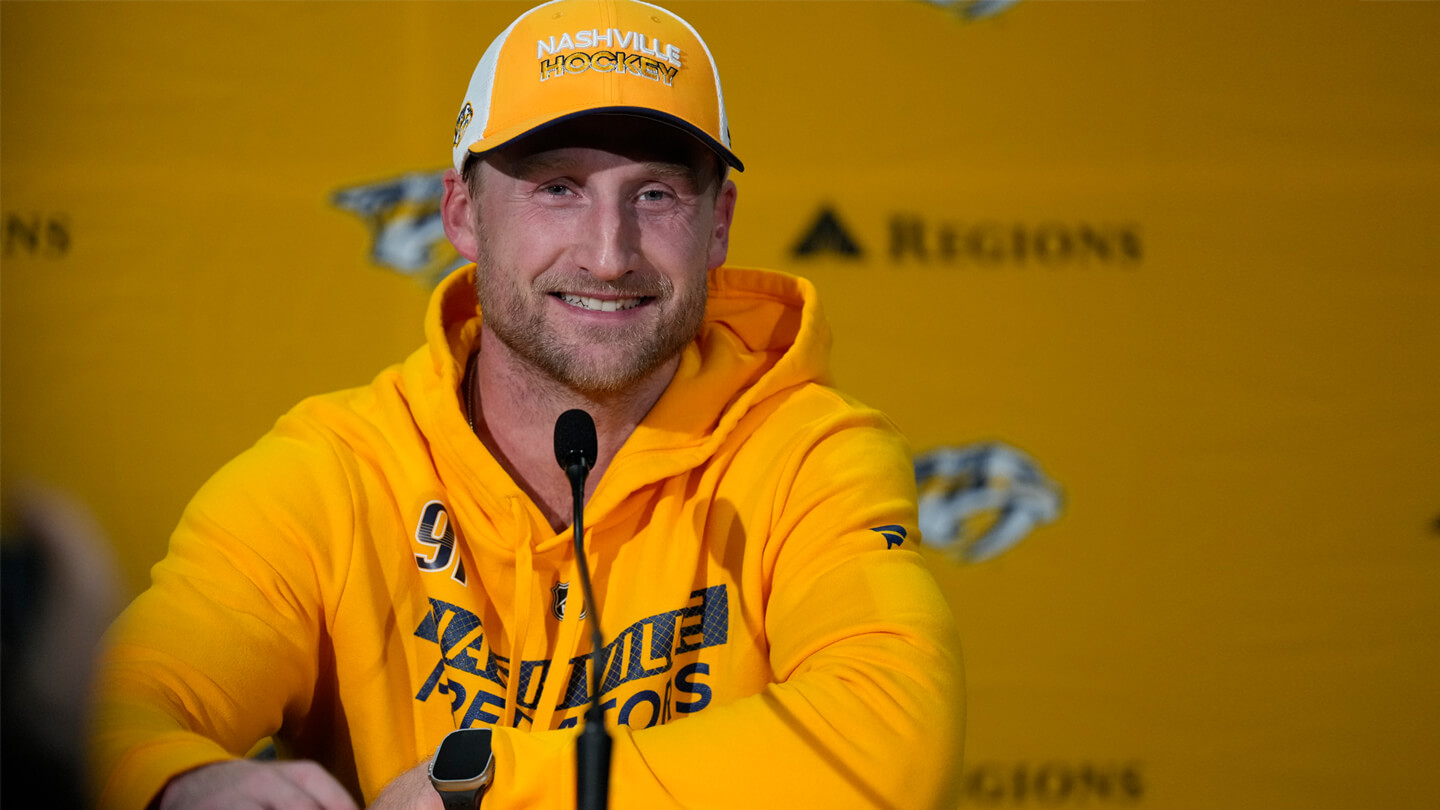
S
teven Stamkos’s alarm went off at 6:30 this morning, like it does every school day. Sometimes he has to wake his son Carter up to get the five year old going early enough: Breakfast eaten, teeth brushed, clothes on, backpack loaded, and out the door to make it by the time kindergarten starts at 7:30 a.m.
This is brand new to Stamkos, and for a couple of reasons. For starters, it’s his first-born’s first year of school — “he’s just a little kindergarten guy,” as the forward puts it. Secondly, there’s that early bell. When Stamkos himself was just a little kindergarten guy, 30 years ago and more than 1,000 kilometres north in Markham, Ont., school started at 9 a.m., and didn’t necessitate his parents waking him up so he’d make it on time.
Well, just add the new morning routine to a year chock full of adjustments for No. 91, who’s wearing something other than a lightning bolt to work for the first time in his NHL career. As he takes the ice at the Ford Ice Center Bellevue for his first skate in Nashville Predators yellow a couple of hours after school dropoff, Stamkos stands at or near the back of the line before every new drill, watching his new teammates run through each before he feels confident enough that he won’t screw up when it’s his turn.
“‘Weird’ isn’t the right word,” to describe how this all feels, Stamkos decides, once that first skate is in the books. Sitting in a chair above ice level, he settles on “different” to capture the feeling of playing anywhere but Tampa after 16 seasons with the Lightning. In Florida, he was the No. 1 draft pick who went on to become captain. “You’re first in line for every drill because you know that drill like the back of your hand — and now it’s the complete opposite,” Stamkos explains. “I don’t know the drills. I’m asking guys where the gym is. It really feels like the first day of school.” After helping Carter navigate that very moment a few weeks ago, now it’s dad’s turn.
Stamkos is the new guy in an NHL market for just the second time in his career. He didn’t think he’d ever play anywhere but Tampa Bay, but this summer the Lightning let their captain walk in free agency, and he signed a four-year deal with Nashville. The team he joins for the 2024-25 season is a far cry from the one-of-a-kind disaster that greeted him when he first moved to Tampa as an 18-year-old, but he’s still faced with the challenge of finding his footing in a new home, while the rest of us get used to the sight of the sniper in a yellow jersey. Stamkos was part of a big splash the Predators made in the off-season, and the team that hasn’t won a playoff series since 2018 now has the look of a contender. Far from ready to ride quietly off into the sunset, Stamkos is eager to play a key part in making that potential a reality — and kicking off this new era with a bang.
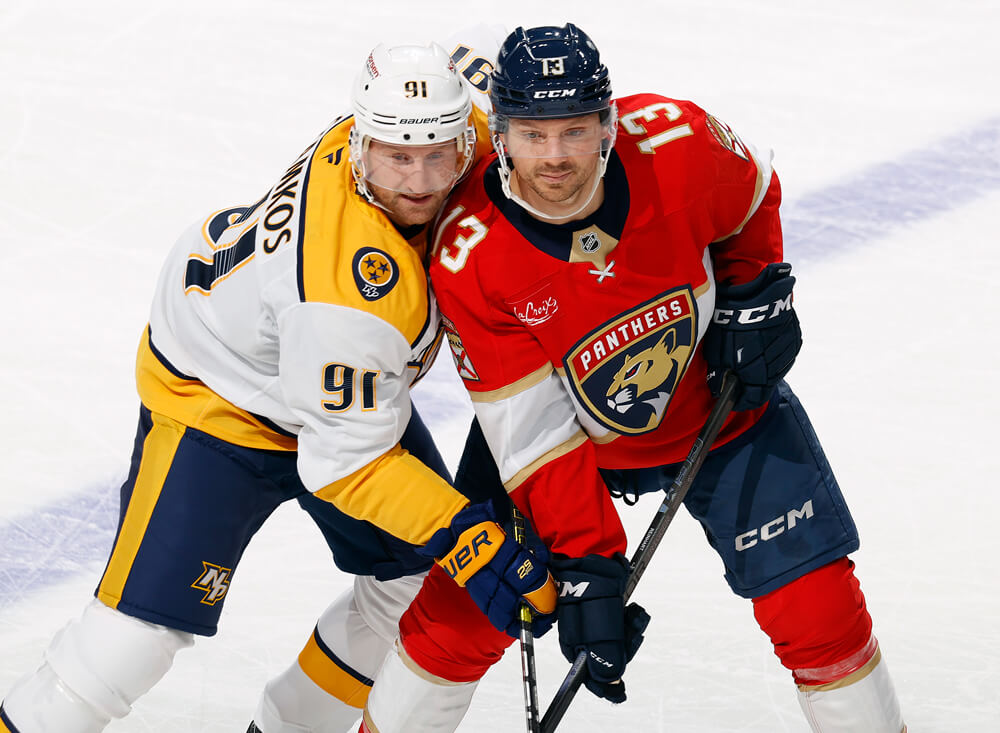
A
head of the 2008-09 NHL season, Marty St. Louis didn’t know much about the kid his Lightning were expected to take No. 1 overall. “I knew he was a righty and I knew he was a goal-scorer — that’s about it,” St. Louis says. “I remember the hype around him, too. There’s always hype with the No. 1 pick, but the organization really took it to another level.”
Months before the Lightning made Stamkos the NHL’s top pick on June 20 in Ottawa, “the signs were everywhere,” St. Louis recalls. “‘Seen Stamkos?’” The slogan appeared on bumper stickers, T-shirts, billboards, bracelets — even dragged behind a plane. There was a ‘Seen Stamkos?’ website that featured Youtube highlight reels along with facts like: Stamkos out-produced Steve Yzerman in his final year of junior. “It really was a brilliant ad campaign,” says Rick Tocchet, who was hired that summer as Tampa Bay’s assistant coach.
It was a crafty marketing move for a team grasping for any good news to show the fanbase. Sources of future excitement were in short supply for the 2004 Stanley Cup champions, who’d finished dead last in the NHL to close out the 2007-08 season. They’d been in a lengthy transition phase when it came to ownership — a potential sale had fallen through in 2007, and then in June of 2008 ownership was officially transferred to Hollywood producer Oren Koules and former NHLer Len Barrie.
Koules and Barrie made big, questionable moves from the get-go. The Lightning fired coach John Tortorella with a year to go on his contract and replaced him with Barry Melrose, who hadn’t coached an NHL game in 13 years. Players were also let go, including defender Dan Boyle, who called the owners “liars” after he was forced to waive his no-trade clause. In July, GM Jay Feaster resigned with three years remaining on his contract. Bryan Lawton, who was new to NHL management, was hired to fill the GM role, and Feaster contended Lawton was making decisions with Koules and Barrie well before his role was official. Tortorella later called the owners “cowboys.”
“It seemed, from the outside, a little bit like Lord of the Flies — who’s running what, you know?” says Barry Trotz, who was then the Predators head coach. “You’re not there, but as an outsider, it didn’t feel very functional.”
Forward Ryan Malone was there, after signing a seven-year deal with Tampa ahead of the 2008-09 season. “Those owners, they didn’t own the team very long, so they were maybe doing some things backwards, like hiring Barry Melrose as our coach,” he says, with a laugh. “I think, unfortunately, Stammer was in the middle of it as a young 18-year-old trying to figure it out, which probably was a little confusing for him. Management maybe didn’t know what to do with him at times, or maybe they had different people saying different things, with different ideas. And there was so much hype around Stammer — they put a lot of pressure on him.”
Stamkos received a standing ovation from the team’s staff when he walked into the St. Pete Times Forum for his first training camp skate, but by the time the season started, the rookie wasn’t the presence on the ice he’d been off it. Coming off a 105-point season for the OHL’s Sarnia Sting, Stamkos played just 8:25 in his regular-season debut, a loss against the New York Rangers in Prague. His parents, Chris and Lesley, planned to be there, but their flight got cancelled. They were in Tampa for their son’s third career game, at home against Carolina, where he saw even less ice time, just 6:05. “I remember sitting on the bench, and I was beside Gary Roberts, who was 42 at the time — they’d brought him in to be this veteran presence and play third- or fourth-line, 10 or 12 minutes a night, and he had played about two minutes,” Stamkos says. “Near the end of the game, he looks at me on the bench and says: ‘I guess they’re saving us for the playoffs, kid.’”
Stamkos laughs at the memory and recalls Roberts storming into Melrose’s office after the game to give the coach his two cents. The veteran’s appeal might’ve had some effect as Stamkos’s time on ice did slowly increase. But by his seventh game, up to nearly 14 minutes, he was still without a point. Media labelled his start a “slump,” just one of the off-ice distractions Stamkos, who calls himself “my own hardest critic,” faced. “Apparently, I was traded to the Rangers,” he says, referencing a rumour that circulated early in his rookie year.
“There was a lot of noise around Stammer,” Tocchet says. “You’re really just trying to protect the kid.”
Fortunately, the kid had a strong support network. His parents visited regularly, and he lived steps away from veterans like Malone, Roberts, and Mark Recchi. He also had the added leadership of a teammate like St. Louis, who in seven seasons in Tampa had experienced highs (like winning the franchise’s first-ever Cup) and lows (you know, finishing last).
St. Louis describes himself as a “big brother” to Stamkos, who’s 15 years younger and closer in age to St. Louis’s then-five-year-old son. “I’d look out for him, try to help him, and I quickly took him under my wing,” St. Louis says. “I always was pretty loose and liked to laugh, and for Stammer seeing that, I think it helped him probably enjoy himself a little bit, loosen up. With high expectations, sometimes you can get lost with the pressure versus the pleasure.”
The five-foot-eight St. Louis had fun with the six-foot rookie, too: “I picked on Stammer, because he has really long legs. Probably from the waist up, we’re the same height,” St. Louis says, laughing.
Stamkos needed any levity he could get. Today, as he looks back, happy memories of his earliest NHL days are in short supply. Even his first NHL point, in Toronto with dozens of family and friends in attendance, doesn’t stand out as a highlight. “To this day, it’s probably one of the worst points I’ve ever had in my career,” Stamkos says. He’s not sure he even touched the puck to earn the assist. “The whole first 20 games of my career, it was tough. There were times I was lying in bed and thinking, ‘Maybe it’s better if I just go back and play junior.’ I had those thoughts, and I had a coach in Barry Melrose that didn’t really believe in me, didn’t really give me a chance, didn’t think I was ready to play. He was such an old-school coach in terms of his mentality that it wasn’t a young guy’s league, and so I never really got an opportunity.”
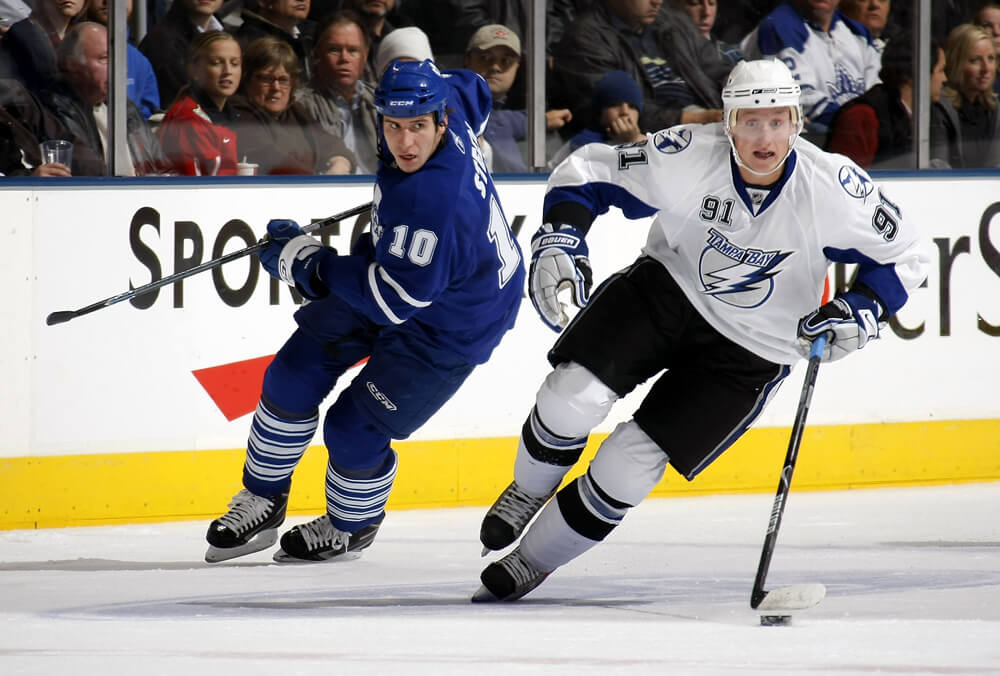
Despite the lack of playing time, there was no doubting the skill Stamkos possessed. “When he came into the league, he was a shooter,” says St. Louis.
“Even at 18, we called him ‘The Hammer,’ because of that one-timer,” adds Malone, who played on a line with Stamkos early that season. “That speed and shot early on, it was incredible. I was like, ‘Oh, I gotta get going here [to keep up].’”
Recchi was also in Pittsburgh for Sidney Crosby’s rookie season and sees a lot of parallels between the superstars when it came to their off-ice maturity. “They both handled things very well being the No. 1 overall, the guy everybody expects to be the franchise player. And you know, that’s not an easy thing – it’s hard. But Steven was prepared for it,” Recchi says. “On the ice, he had that bomb for a shot, he was a good skater, and he was competitive, which is all you ask for.”
Stamkos saw time on the power play, but Tocchet recalls having to remind some on the Lightning staff to have patience with the centreman. “I’m not going to mention the people [in the organization], but a couple of people said, ‘Why don’t you change the power play breakout? He can’t take a pass off his backhand,’” Tocchet recalls. “And I said, ‘Well, he’s an 18-year-old kid. He’s got elite talent. We’re going to continue this until he becomes great, and he’ll work at it.’ And then after a month or two, yeah, he made mistakes, but because we continued and he worked on it, he was elite.”
Tocchet laughs: “He figured it out very, very quickly.”
Stamkos scored his first NHL goal on the power play, and his second later the same night at even-strength, in his ninth career game, a 5-2 win over Buffalo. It was a rare win for the Lightning, who opened the season with five straight losses.
Sixteen games in, after dropping three in a row to fall to 5-7-4, Melrose was fired. Tocchet took over as head coach, and decided a new approach was necessary for the rookie who’d tallied just four points. “I thought he was struggling a little bit and I wanted Stammer to realize: Let’s have a gameplan,” Tocchet says. “We know you’re going to be a great player, so what’s the process? Let’s change the process.”
Tocchet, who leaned on both Roberts and Recchi as confidantes, set up a schedule that saw Stamkos play two or three games then sit one out as a healthy scratch to allow for a heavier workload in the gym. The goal was to get him stronger. “I thought it was the right thing to do at the time, and it was an organizational decision,” Tocchet says. “How are we going to get this kid in the best position for him to maximize his talent?”
The games he didn’t play Stamkos, Tocchet says, “I took a lot of flak, and people were like: ‘What the hell are you doing?’”
During his nights off, Stamkos either lifted weights and watched the game on TV or worked out earlier in the day and then headed to the press box to take notes on the centres who were playing. “I remember thinking, ‘What the heck is going on?’” he says.
“That was hard on him,” St. Louis says. But, adds Recchi, “he didn’t complain one bit. I mean, I wouldn’t be happy either. But he understood, and he embraced it. And it worked.”
Stamkos focused on working hard in the gym, doing everything asked of him. “At that point, I used it as like an ‘eff-you’ type of mentality: ‘I don’t want to keep doing this, I want to play, so I better use it as fuel,’” he says.
Now, 16 years later, Tocchet can’t remember how many games his star rookie was a healthy scratch, only that the plan was short-lived. Stamkos remembers, though. “It was three — I remember like it was yesterday,” he says. “I think I scored a couple of goals. I was playing well and they were like, ‘Okay, screw it, let’s just play him.’
“And at that age, and especially with how that year had gone by the time Tocchs took over, they had to come up with something to try to help me along,” he adds. “It was a little bit of an eye-opener for me. I didn’t want to be missing games as a healthy scratch. But to this day I still look at that season and I see I missed three games, and that’s why, because I was taking notes in the stands.”
Stamkos’s final game taking notes was Jan. 29, 2009. In mid-February, he registered his first career hat-trick, and played at a nearly point-per-game clip the rest of the season, with 24 in his last 26 games, including 16 goals. His 23 total goals ranked third among rookies. “All of the sudden, the kid was filling the net,” Tocchet says.
“He took off, and never looked back,” St. Louis adds.
Looking back on that season, Tocchet is most proud of Stamkos for maintaining his focus and not letting the noise affect him. “The one thing I was concerned about for him is there was turmoil with the team, and sometimes when you have things that are disjointed in the organization, it can hurt a player’s growth, especially a young player,” Tocchet says. “But he kept his foundation together even though things were a little bit rocky inside and outside. He didn’t use any of it as an excuse — I think he actually used it as fuel. I think it really helped him, kind of, cocoon himself, use his mental toughness. He deflected all that stuff and continued to keep his head down and work on his game.”
Stamkos is thankful social media wasn’t as prevalent in those days. But even without that added noise, “it wasn’t easy,” he says, with a laugh. “And I’ve always had that high expectation of myself as a player. You know it’s not going to be easy when you make the jump to the NHL, but it certainly went the complete opposite of what I envisioned.”
He also appreciates the fact Tocchet gave him a chance to earn time on a line with a player like St. Louis, and on that No. 1 power-play unit — and for the veteran teammates he played with, who reminded him his rookie experience wasn’t exactly ordinary.
“There were a lot of crazy things that happened my rookie year where I had guys like Gary Roberts and Mark Recchi say, like, ‘Listen, we’ve been in the league 20 years, this normally doesn’t happen,’” Stamkos says, laughing. “Whether it was with ownership or me being apparently traded — there was so much stuff that went on that are not typical NHL things that happen. I got to experience it all at an early age.
“I learned a lot that season.”

W
hen Ryan O’Reilly ran into the kitchen to tell his wife, Dayna, she asked him to repeat the news “because it didn’t seem real at first,” he remembers. Once it began to sink in for her, O’Reilly called his parents and opened the conversation with an excited, “Have you heard?” They hadn’t, and when he told them Steven Stamkos had signed with the Predators, his mom screamed with excitement.
Roman Josi was driving and noticed his phone lighting up so many times he pulled over to see why. His group chat with teammates, including Filip Forsberg, Gustav Nyquist, Luke Schenn, and O’Reilly, was going non-stop about the Stamkos news. “I knew we were trying to get Stammer, but a guy like that, you’re hoping for it, but you don’t actually believe that it’s going to happen,” the Predators captain says, smiling. “We were all texting, and I was like, ‘Oh my god, this is crazy!’”
Predators general manager Barry Trotz got a lot of messages, too, from players and others in the organization. All of them were some version of: “I am pumped!”
“That’s when you know you’ve done a good job,” Trotz says, of July 1, a day that many a Predators player has since likened to Christmas, when Nashville kicked off 2024’s free-agency period by signing not only Stamkos but also fellow 40-goal scorer Jonathan Marchessault and defender Brady Skjei.
Trotz admits he didn’t think Stamkos would be available. Sure, he’d casually asked Julian BriseBois how negotiations with their captain were going when he’d seen him at the NHL awards on June 27. And yeah, the Lightning GM had told Trotz he didn’t think they were going to get a deal done. But still, “like everyone I thought, ‘Oh, they’ll get it done,’” Trotz says.
When they didn’t, Trotz went to work trying to sign the player he calls “a serial winner.”
“I knew I could not fail in this, if Steven came here,” the GM says, with a chuckle. “There’s the player part, and then there’s the intangibles part, and both are in very good hands.”
While the beginning of July brought cause for celebration in Nashville, back in Tampa, Stamkos and his wife, Sandra, were going through a more complicated mix of emotions, in tears over their new reality. They’d be leaving their long-time home, where Stamkos scored 555 career regular-season goals and raised two Stanley Cups, where Carter, two-year-old Chase, and four-month-old Olivia were born. “I have no shame in saying the first two weeks in July were very difficult for my family and I, we were going through a lot,” Stamkos says. “Sometimes the scary part is when you have too much time to think, because all the thoughts go on inside your head — ‘Did I make the right decision? Did I not?’ — instead of just going out and playing.”
With all that time, Stamkos spent the first half of July wondering how difficult the move would be on his young family. “It’s easy to make a selfish decision because of what I’m feeling towards certain people, or why I want to make this decision. But it’s not about me at this point in my career anymore — it’s a family decision,” Stamkos says. “And my wife’s great, she’s not going to fight me on something that I feel strongly about, but I could tell there was some hesitation. And that’s the toughest part, is thinking about your family.”
Carter and Chase were the first members of the Stamkos crew to come around to the idea. The Predators delivered a care package after Stamkos signed, including stuffies of Gnash (the mascot), mini sticks, and little No. 91 Predators jerseys with “Daddy” on the back. “They were wearing them every morning for a week, so they changed alliances pretty quick,” Stamkos says.
He and Sandra took a while longer. Trotz, who was the Predators’ first coach and was then let go after 15 seasons, could relate, and shared his experience of leaving a place your family has made a long-time home with Stamkos. “I told him what I found: It hurts. It hurts and it feels strange,” says Trotz, who was then hired by the Washington Capitals. “But then what I found is it can be reinvigorating. And you realize, this other group of people loves me, and this is going to be exciting.”
When Stamkos had his first face-to-face meeting with Trotz, in August, he told his new GM: “I know what you mean now.”
It’s a shift he first felt in mid-July. “Once my wife and I came to terms with it, we started to try to reinforce why the decision was the right one … telling yourself this is why it was right, this is what we’re going to do, this is what’s going to be great,” Stamkos says. “You start thinking like that and it helps. And it’s like you wake up one morning and that feeling that you’ve had in your stomach for two weeks, it’s gone.”

A couple days after the family moved to Nashville, Gnash visited to play mini-stick hockey with Carter and Chase. The kids were extra sold, then.
Nashville’s team services staff took care of a lot of logistical details. Carter had a doctor and was signed up for school, baseball, and hockey even before they moved. “He’s living his life here now— I feel like an Uber driver,” Stamkos says. Carter plays on the same U-8 Nashville Jr. Preds hockey team as Schenn, Marchessault, and O’Reilly’s kids. “We’re all hockey dads together,” Schenn says, and they also run into each other at school drop-off and pick-up.
The Stamkos family bought a house in the same neighbourhood as the Schenns. Stamkos and Schenn are long-time friends who went through the 2008 draft together, won back-to-back Cups in Tampa together, and now drive to the rink in Nashville together. Their parents are friends and Schenn says their wives, Sandra and Jeska, “talk even more than we do — and we talk a lot.”
When Schenn moved to Tampa ahead of the 2020-21 season, Stamkos invited the defender to live with his family as he got settled, and loaned him a car. Schenn, who signed a three-year deal with the Predators in 2023, is now helping his pal’s family feel comfortable in their new home, showing Stamkos the best local golf club, some favourite restaurants, and getting their families together for events like the Tennessee Titans home opener.
Now that he’s in Music City, Stamkos has been to a concert, too — not that he likes music much. “He drives in silence,” Schenn says, shaking his head. “Like, that’s just unheard of.”
Stamkos had fun at the Dirks Bentley concert in early September, though, mostly because it was a chance for him and Sandra to meet his teammates’ significant others. He was hopeful Sandra would find some good friends in that group. “They’re forced to be friends because of us, so there’s that dynamic,” Stamkos says. “And we had such a good time, everyone was great and welcoming. It was a really fun night for both of us to kind of let loose and embrace the setting we’re in.”
Nashville may not feel like home just yet, but many of the early worries Stamkos had about the move have already been put to bed. His season kicks off at Bridgestone Arena on Oct. 10, as the Predators host the Dallas Stars, and at the end of October, Stamkos will play against the Lightning for the first time in his career, in his old home — the city where he and nearly everyone else in hockey figured Stamkos would spend his entire career.
Recchi, who’s now coaching in Columbus, says it was “heartbreaking to see” Stamkos leave Tampa. “His leadership qualities are incredible. And to me, outside looking in, he’s changed his game. He’s become a physical player, a guy that in the playoffs knows what they’ve got to do to be successful, so he does it. I felt he led the charge in Tampa for them,” Recchi says. “I think Stammer’s going to do unbelievable in Nashville, and he’s going to really help them.”
Adds St. Louis: “He’s evolved so much as a leader, and obviously what they built in Tampa the last 10 years, Stammer has a lot to do with that. I’m really proud of him.”
A two-time winner of the league’s scoring title, Stamkos hit the 40-goal mark for the seventh time last season, and led Tampa in playoff goals, notching five in their first-round series against the eventual-champion Florida Panthers. His long-time friend, Schenn, points out Stamkos is finding different ways to score as his career progresses. “I think the older he’s gotten, the smarter he’s gotten in terms of knowing where to go,” Schenn says. “You’re not getting faster with age, but you’re getting more creative. And there’s an art in finding different ways to produce when you’ve always kind of had a circle around your name, when guys are aware of where you are on the ice. And to be able to produce like that at this high a level for this long, it takes a special player to do that.”
That this special player is now in Nashville still hasn’t sunk in for some members of the team. “It’s funny, he’s been here for a while now, but still, it’s going to be weird, but so cool, to see him in that Preds jersey, right?” O’Reilly says, grinning ear-to-ear.
Forward Luke Evangelista watched countless hours of Stamkos highlight reels on YouTube as a kid, and now the 22-year-old gets to see Stamkos’s skill and day-to-day habits in person, not to mention taking the ice with him. “My first skate with him, I put, like, the first three passes right in his feet,” Evangelista says, laughing. “I went over and apologized. I said, ‘I don’t usually do this. I’m a little nervous.’” The idea of playing on a line with No. 91 is “a dream come true,” he says. “It’s hard not to think about that.”
Josi, who’s worn the ‘C’ in Nashville since 2017, is thankful to add the experience of a guy who’s twice raised the Stanley Cup to the dressing room. “I love learning from guys like him that have had so much success. Obviously, I’m going to be leaning on him a lot this year to help me out with the leadership stuff,” he says.
O’Reilly likes to picture the help Stamkos will provide to the team’s power play. “I’m sure he’ll probably be in his spot where he’s scored his 500 goals — it probably makes the most sense to have him there,” he says, laughing. “I mean, you see him in our little skates and scrimmages and [anytime]he gets one-on-one with the goalie, it’s in the back of the net. He’s one of the purest shooters of all time. He’s the guy you’re always thinking: ‘Where is he? What’s he gonna do?’ So, to have that threat on our side now where we don’t have to worry about it, we can watch it — it’s gonna be so fun.
“It’s still surreal when you see him and the other players we’ve added to our team,” O’Reilly continues. “It’s gonna be tough, but there’s confidence here that we can do this.”
That, of course, is part of the reason Stamkos chose to sign with Nashville.
“I didn’t just come here for fun, to play four more years and sail off into the sunset — I want to be a guy that’s counted on to help this team win, and to win a Stanley Cup,” he says.
But this time around, he’ll be trying to do that in Nashville. And while everything still feels not quite “weird,” but “different,” Stamkos has decided that can be a good thing.
“Not that I was going through the motions before, but here, I feel like I’m on my toes all the time, like I’ve got to make sure I’m doing things right,” he says. “And maybe that motivates you even more. I think it does.”
George Walker IV/AP; Joel Auerbach/Getty Images; Dave Sandford/Getty Images; Mark LoMoglio/NHLI via Getty Images; Johnnie Izquierdo/AP.



